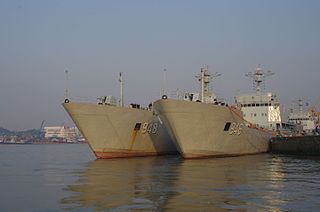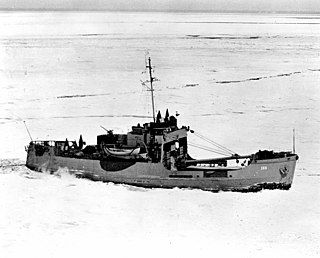Related Research Articles

A midget submarine is any submarine under 150 tons, typically operated by a crew of one or two but sometimes up to six or nine, with little or no on-board living accommodation. They normally work with mother ships, from which they are launched and recovered and which provide living accommodation for the crew and support staff.

Project 629, also known by the NATO reporting name Golf, was a class of diesel-electric ballistic missile submarines that served in the Soviet Navy. All boats of this class had left Soviet service by 1990, and have since been disposed of. According to some sources, at least one Golf-class submarine was operated by China, to test new submarine-launched ballistic missiles (SLBMs).

The People's Liberation Army Navy Surface Force is the surface warfare branch of China's People's Liberation Army Navy (PLAN), consisting of all surface vessels in operational service with the PLAN. The PLAN Surface Force operates 661 ships organized into three fleets: the North Sea Fleet, the East Sea Fleet and the South Sea Fleet.

The Type 062 gunboat is a class of gunboat of the People's Liberation Army Navy first developed and constructed in the 1950s. This unsophisticated class is relatively well-armed for its size and is the most widely built and exported Chinese naval vessel in terms of numbers. A total of 30 were built, initial boats being known as the Shanghai I class and later slightly improved boats being known as the Shanghai II class. The Shanghai I class was slightly smaller than its successor, the Shanghai II class, displacing 125 tons instead of 135 tons, and had a twin Chinese Type 66 57 mm gun mount forward. All other specifications are identical to the Shanghai II class, which replaced the 57 mm with twin 37 mm gun mounts. Some boats remained in active service well into the early 1990s in the PLA navy and longer in the case of the Korean People's Navy.

The Type 073 landing ship is a family of landing ships developed and operated by the People's Liberation Army Navy, it consists of several models. This article details the development of this class that begun in the 1960s. The most recent and modern model of the class is the Type 073A, which were built and commissioned in the 2000s.

The Type 722 II class LCAC with NATO reporting name Jinsha II class LCAC is a medium size air-cushioned landing craft (hovercraft) operated by the People's Liberation Army Navy of China. It is frequently but erroneously referred by many as Dagu class, its predecessor, due to misspelling and lack of information in the 1970s, when these projects first appeared. There are also other names for this class, mostly resulting from different transliterations.
Osprey class submersible is a class of submersible of the People's Liberation Army Navy (PLAN) specially designed to perform torpedo retrieving missions at test ranges. This class submersible was highly classified when it originally entered service in 1989, and it was not until more than a decade later in the mid of the first decade of the 21st century when it was revealed to the public, when one of the design team members, the deputy general designer Mr. Sun Xin (孙欣), was publicized in a 2006 interview to disclose some characteristics of the submersible. This class is currently consisted of two boats, Osprey 1 and Osprey 2.
The Jinyou-class oil tanker is a class of Chinese tanker ship that is in service with People's Liberation Army Navy (PLAN). A total of three units were built by Japanese Kanashashi Shipyard and entered service with PLAN between 1989 – 1990. These unarmed tankers were upgraded with Chinese radars after delivery, but remain unarmed. One unit was subsequently converted to water tanker (AWT) and remains in active service in mid 2010s, but it is unclear which one of the three oilers the water tanker was converted from. Specification:
Type 744 buoy tender and its derivatives with the NATO reporting name Yannan (延南) class is a class of Chinese buoy tender that is in service with the People's Liberation Army Navy (PLAN) and Chinese civilian governmental establishments. It is a boat or vessel which services and replaces buoys.
Type 991 cable layer is a family of Chinese cable layers first saw service in Chinese navy, and later on, additional units also entered service with Chinese civilian authorities.
Type 912 degaussing/deperming ship (ADG) is a type of little known auxiliary ships built in the Republic of China (PRC) for the People's Liberation Army Navy (PLAN), and this class has several derivatives. As of 2022, Type 912 is the most numerous degaussing/deperming ship in PLAN, and the longest serving degaussing/deperming ships in PLAN, until its successor ype 911 finally begun to appear in early 2010s.
Type 645 oceanographic research ship is an oceanographic ship developed by China for the People's Liberation Army Navy (PLAN) and other Chinese civilian establishments. Type 645 was an experimental program of the Fourth five-year plan of China and designed by the 2nd Directorate of 708th Institute of China State Shipbuilding Corporation, which is also more commonly known as China Shipbuilding and Oceanic Engineering Design Academy (中国船舶及海洋工程设计研究) nowadays. Construction begun in October 1977 and the ship was launched in October 1978, entering service with PLAN in December 1978. There are a total of twelve laboratories on board totaling 257 square meters. Deployment proved that the design was successful, and three more units were built for civilian use, named as Xiangyanghong 9, Xiangyanghong 14 and Xiangyanghong 16 respectively. However, on May 2, 1993, Xiangyanghong 16 was rammed and sunk by a Cypriot LNG carrier more than nine time of its size in the East China Sea near Jeju Island, with the loss of three crew members. The sister ships in civilian service are often tasked with military and paramilitary missions and thus frequently come under PLAN and Chinese Coast Guard control.
Type 614 research vessel is a type of Chinese research vessel in service with the People's Liberation Army Navy (PLAN). The ship has two derivatives, one is in weather ship configuration, and the other in oceanographic research ship configuration. Type 614 research vessel has been replaced by Type 625.
Type 922 rescue and salvage ship is a series of rescue and salvage ships developed by China for the People's Liberation Army Navy (PLAN), and after decades of service they still remain active in other Chinese governmental establishments.
The Type 830 sea-going rescue tug is a type of naval auxiliary ship currently in service with the People's Liberation Army Navy (PLAN). Type 830 has received NATO reporting name as Tuozhong class. A total of three have entered services with PLAN.

USCGC Basswood (WLB-388) was an Iris-class buoy tender belonging to the United States Coast Guard launched on 20 May 1943, and commissioned on 12 January 1944.
Type 52 gunboat was a type of gunboat developed by China for the People's Liberation Army Navy (PLAN) in the early 1950s, and it was the first indigenously developed gunboat in the People's Republic of China (PRC) that entered mass production
Type 80 demolition boat is a type of little known obstacle clearance boat built in the People’s Republic of China (PRC) for the People's Liberation Army Navy (PLAN). The origin of Type 80 demolition boat is rooted back in the early 1960s when Factory No. 425, the predecessor of Wuhu Shipyard first developed a wooden demolition boat designated as Type 308 for PLAN. Type 308 demolition boat was intended to be used in the first wave of amphibious landing operations to clear out obstacles on the beach for landing forces. Production of Type 308 demolition boat begun in January 1960, and the first unit was launched in June that year. Due to the political turmoil in China at the time, namely, Great Leap Forward, the boat was turned over to PLAN on July 11, 1960, long before sea trials had been conducted, which was not completed until two years later in 1962. Specification of Type 308 demolition boat: